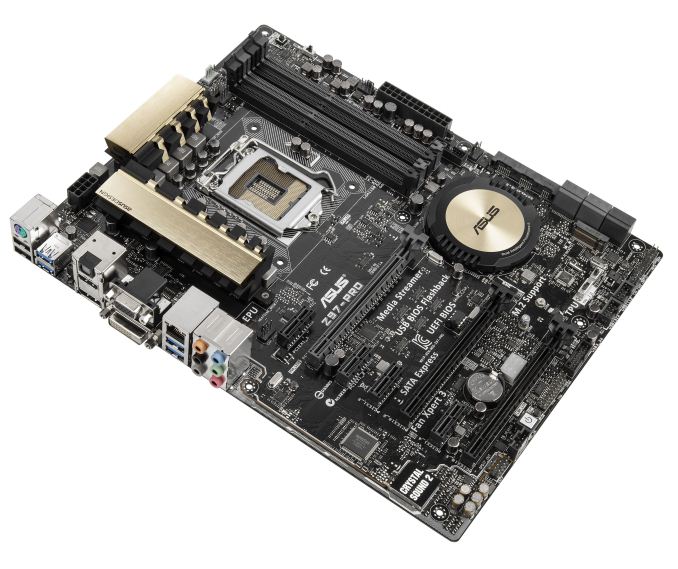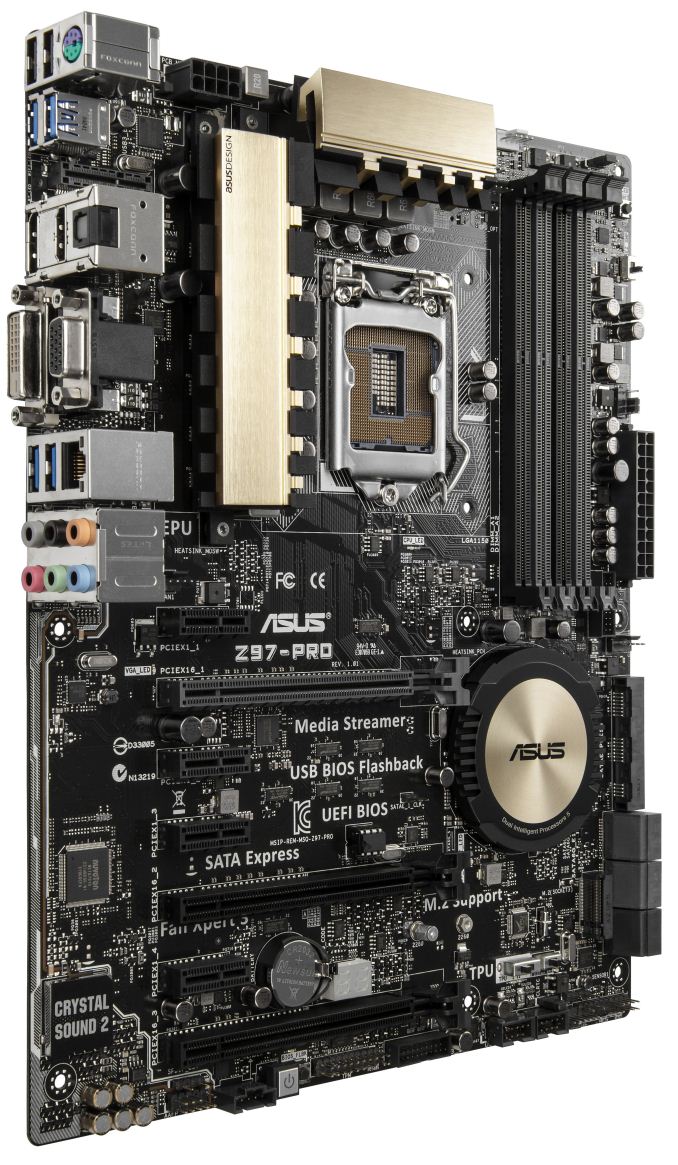ASUS Z97-Pro WiFi AC Review
by Ian Cutress on July 16, 2014 10:00 AM EST- Posted in
- Motherboards
- Asus
- Haswell
- 802.11ac
- Z97
ASUS Z97-Pro WiFi AC Conclusion
The to-and-fro with regards to the new SATA Express and M.2 storage options is not going to go away any time soon. PCIe storage is here to stay, but in the interim motherboard manufacturers have a tough choice to make between M.2 support, SATAe support, or both with some fancy PCIe lane management. ASUS at that point is going to have to be committed to SATAe due to their involvement with ASMedia, and ASMedia is the only company with a SATAe controller in the consumer market. It would seem that this controller is destined for $250+ motherboards, given that the Z97-Pro only has one SATAe from the chipset. It also depends on Intel’s support of SATAe, and whether it will expand in future chipsets to more than one x2 topology.
With that aside, the Z97-Pro has been a solid part of our CPU test bed. In terms of swapping out CPUs, GPUs and memory, I have not come across a problem. The key point in the performance metrics actually comes from the audio, where our motherboard achieved 105.1 dB dynamic range and -84.8 dB THD+N, and the DPC Latency came in under 100 microseconds.
The big challenges from ASUS’ perspective should be the Z97X-SOC, Fatality Z97 and Z97 Gaming 7 which are all in that $188-$210 bracket. ASUS 9-series BIOS shows that growth in these areas are still happening and similar to our Z97-Deluxe review conclusion, having the automatic overclocking option to determine maximum temperature and length of stress testing is something I imagine all other motherboard manufacturers taking on board relatively soon. It should be easy enough to implement as well. While I might not be the BIOS’ biggest fan, the EZ mode and My Favorites menus are evolving, and the fan controls in the BIOS are now second to none. My only additions to those fan controls would be an option to set all fans to ‘high speed’ or ‘silent’ with one click, as is possible in software, and also a measure of hysteresis.
The addition of 802.11ac 2T2R WiFi might have come across as a bit pricy, originally being a $30 addition but has now moved down to +$12. The module cannot be purchased individually and one might argue that a PCIe card to do something similar would cost more, making the WiFi module a good investment. Given that ASUS now ship 3T3R 802.11ac routers, including the dual 3T3R AC3200 model announced at Computex, I wonder how close we are to seeing 3T3R solutions on motherboards. My expectation lies at the feet of X99, however the additional cost is a bit more difficult to predict. Nonetheless, the WiFi option of the Z97-Pro is preferred as a ‘just-in-case’ option should a user’s circumstances change. The XMP switch is also a nice touch that other manufacturers might implement, helping enthusiasts get the full speed out of their memory without worrying about accessing the BIOS.
Even at $200 the system punches above its weight, and the lack of issues across my testing with almost a dozen CPUs for other reviews can only ever be a positive. Users investing into the Z97 ecosystem should consider the Z97-Pro or the Z97-Pro WiFi AC as worthwhile motherboards in their builds.













38 Comments
View All Comments
DanNeely - Wednesday, July 16, 2014 - link
Where're you finding it for <$200? Newegg has it at $219. The shopping search in the where to buy link picks up several lower spec models in the same family.owan - Wednesday, July 16, 2014 - link
Reading all these z97 reviews only underscores how badly intel needs to increase the number of available PCIe lanes, particularly the 3.0 lanes off the CPUGigaplex - Wednesday, July 16, 2014 - link
That's why Intel has the enthusiast socket 2011 platform.DanNeely - Friday, July 18, 2014 - link
Unfortunately Intel's kept it crippled by delaying the enthusiast CPUs using it until they complete all the extra testing/validation they claim is needed for Xeons but not regular consumer parts. If they'd release the enthusiast parts at about the same time as the mass market ones and then the Xeon's a year later it'd get much more respect. As it stands, it's basically just smoke and mirrors.rchris - Wednesday, July 16, 2014 - link
Appreciate the fine review. However, I really wish product reviews would include some data or sampling of the manufacturer's customer service performance. I know there are feedback comments on sites such as Newegg.com, but they are all horror stories and it's hard to tell if they represent what typically happens when you get a lemon and have to deal with it.ggathagan - Wednesday, July 16, 2014 - link
What would be better would be an investigative article that dealt solely with the quality of customer service from all the manufacturers over a period of, say 2-3 months.There are only a handful of motherboard providers. To add this to every review would be needlessly redundant.
Customer service tends to be quite hit-or-miss, since so much of it depends on the individual who takes your call.
Farwalker2u - Wednesday, July 16, 2014 - link
Hysteresis, the dependence of the output of a system not only on its current input, but also on its history of past inputs.I had to look it up.
I never knew there was such a system. Your suggestion for additional fan settings with this as part of the mix makes sense.
demonqueller - Friday, July 18, 2014 - link
No Firewire ports on this board either. Since they were lacking on Asrock's and MSI's offerings, does this mean Firewire is dead? Those of us with external Firewire audio interfaces have to rely once again on third-party add-on cards. Not a huge deal, but the extra cost (and crowding on the board) is annoying.DanNeely - Friday, July 18, 2014 - link
Yeah, it's more or less dead. At this point it's not even so much the $5-10 that adding the controller/port increases the retail cost. It's that the controller eats a PCIe lane and Intel doesn't give us enough of them; virtually every mid/high end ATX motherboard is either having lane allocation switched around in software or using a PLX as a port multiplier to add more lanes. FW lingered as long as it did because as long as you had a PCI controller (either in the chipset or a PCIe-PCI bridge chip) you could hang several devices off it for the cost of routing traces to them.The rumor is that Intel will be increasing CPU PCIe lanes on Skylake from 16 to 20; but with that ostentatiously being about PCIe based storage; they really need to offer an enthusiast chipset with 12 or 16 lanes instead of 8 too.
demonqueller - Friday, July 18, 2014 - link
Yes, more lanes would be nice. ... I'm building a new rig using the 4790K chip to replace my ancient CoreDuo 8400. I haven't settled on a board yet; I'm wavering between this ASUS or ASrock's Extreme 6. The computer primarily will be used for music recording / mixing, but I also do 3D work. Anyway, my old rig, with a max of 8GB RAM struggled. I hope that won't be an issue anymore with 32GB, even if I'm using a PCI card to support my Firewire ports.